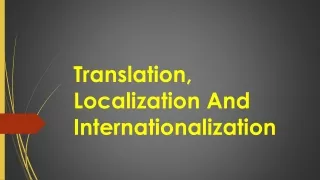audio to text transcription in united states
The words translation, localization and internationalization sound similar and many people use them interchangeably. However, there are subtle differences that set them apart from each other. Understanding them in their context is important for people and companies that want to make their business reach a global level. Out of all the three terms, translation is the easiest to understand as it basically involves the conversion of existing text from one language to another. But the rest two are slightly different and this blog will help you learn the similarities and differences between the three. It is the process where the meaning of a content piece is communicated in another language. Translation is a very meticulous task and requires advanced knowledge of both the source and target languages. If it is not done correctly or by an inexperienced translator, the output might not communicate the appropriate message and it could also end up being a word-for-word conversion. There are also chances that the translation could be confusing, offensive or humorous, which could affect the reputation of a brand. For example, Arabic as a language has several linguistic differences and if the translation is not done properly, it could offend the target audience. The translation may, at times, fail to consider cultural preferences as the process strictly follows the text and message of the source language. To overcome this issue, localization is recommended.
★
★
★
★
★
87 views • 7 slides


